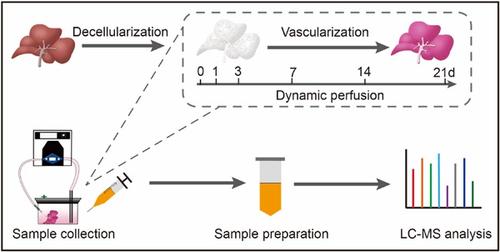当前位置:
X-MOL 学术
›
Biotechnol. Bioeng.
›
论文详情
Our official English website, www.x-mol.net, welcomes your
feedback! (Note: you will need to create a separate account there.)
Dynamic alterations of metabolites revealed the vascularization progression of bioengineered liver
Biotechnology and Bioengineering ( IF 3.5 ) Pub Date : 2022-07-21 , DOI: 10.1002/bit.28189 Qian Zhou 1 , Beibei Guo 1 , Deying Chen 1 , Heng Yao 1 , Xi Liang 2 , Jiaojiao Xin 1, 2 , Dongyan Shi 1, 2 , Keke Ren 1 , Hui Yang 1 , Jing Jiang 1, 2 , Jun Li 1, 2
Biotechnology and Bioengineering ( IF 3.5 ) Pub Date : 2022-07-21 , DOI: 10.1002/bit.28189 Qian Zhou 1 , Beibei Guo 1 , Deying Chen 1 , Heng Yao 1 , Xi Liang 2 , Jiaojiao Xin 1, 2 , Dongyan Shi 1, 2 , Keke Ren 1 , Hui Yang 1 , Jing Jiang 1, 2 , Jun Li 1, 2
Affiliation

|
Vascularization is a critical but challenging process in developing functional bioengineered livers with the decellularized liver scaffolds (DLSs) and the process is accompanied by cell-specific metabolic alterations. To elucidate the dynamic alterations of metabolites during vascularization, rat DLSs were vascularized with human umbilical vein endothelial cells and liquid chromatography mass spectrometry-based metabolomics was performed on culture supernatants collected at 0, 1, 3, 7, 14, and 21 days. Overall, 1698 peak pairs or metabolites were detected in the culture supernatants, with 309 metabolites being positively identified. The orthogonal partial least-squares discriminant analysis and functional enrichment analysis revealed three phases that could be clearly discriminated, including Phase D1 (cell proliferation and migration), Phase D3D7 (vascular lumen formation), and Phase D14D21 (functional endothelial barrier formation). Seventy-two common differentially abundant metabolites of known identity were detected in these three phases when compared with Day 0. Of these metabolites, a high level of β-Alanine indicated a better degree of vascularization and 14 days of in vitro dynamic culture is required to develop a functionalized vascular structure. These results enriched our understanding of the metabolic mechanism of DLS vascularization and indicated that β-Alanine could function as a potential predictor of the patency of vascularized bioengineered livers.
中文翻译:

代谢物的动态变化揭示了生物工程肝脏的血管化进程
血管化是使用脱细胞肝支架 (DLS) 开发功能性生物工程肝脏的关键但具有挑战性的过程,该过程伴随着细胞特异性代谢改变。为了阐明血管化过程中代谢物的动态变化,用人脐静脉内皮细胞对大鼠 DLS 进行血管化,并对在 0、1、3、7、14 和 21 天收集的培养上清液进行基于液相色谱质谱的代谢组学。总体而言,在培养上清液中检测到 1698 个峰对或代谢物,其中 309 个代谢物被阳性鉴定。正交偏最小二乘判别分析和功能富集分析揭示了可以明确区分的三个阶段,包括阶段 D1(细胞增殖和迁移),D3D7 期(血管腔形成)和 D14D21 期(功能性内皮屏障形成)。与第 0 天相比,在这三个阶段中检测到 72 种已知身份的常见差异丰富代谢物。在这些代谢物中,高水平的 β-丙氨酸表明血管形成程度更高,需要 14 天的体外动态培养开发功能化的血管结构。这些结果丰富了我们对 DLS 血管化代谢机制的理解,并表明 β-丙氨酸可以作为血管化生物工程肝脏通畅的潜在预测因子。与第 0 天相比,在这三个阶段中检测到 72 种已知身份的常见差异丰富代谢物。在这些代谢物中,高水平的 β-丙氨酸表明血管形成程度更高,需要 14 天的体外动态培养开发功能化的血管结构。这些结果丰富了我们对 DLS 血管化代谢机制的理解,并表明 β-丙氨酸可以作为血管化生物工程肝脏通畅的潜在预测因子。与第 0 天相比,在这三个阶段中检测到 72 种已知身份的常见差异丰富代谢物。在这些代谢物中,高水平的 β-丙氨酸表明血管形成程度更高,需要 14 天的体外动态培养开发功能化的血管结构。这些结果丰富了我们对 DLS 血管化代谢机制的理解,并表明 β-丙氨酸可以作为血管化生物工程肝脏通畅的潜在预测因子。
更新日期:2022-07-21
中文翻译:

代谢物的动态变化揭示了生物工程肝脏的血管化进程
血管化是使用脱细胞肝支架 (DLS) 开发功能性生物工程肝脏的关键但具有挑战性的过程,该过程伴随着细胞特异性代谢改变。为了阐明血管化过程中代谢物的动态变化,用人脐静脉内皮细胞对大鼠 DLS 进行血管化,并对在 0、1、3、7、14 和 21 天收集的培养上清液进行基于液相色谱质谱的代谢组学。总体而言,在培养上清液中检测到 1698 个峰对或代谢物,其中 309 个代谢物被阳性鉴定。正交偏最小二乘判别分析和功能富集分析揭示了可以明确区分的三个阶段,包括阶段 D1(细胞增殖和迁移),D3D7 期(血管腔形成)和 D14D21 期(功能性内皮屏障形成)。与第 0 天相比,在这三个阶段中检测到 72 种已知身份的常见差异丰富代谢物。在这些代谢物中,高水平的 β-丙氨酸表明血管形成程度更高,需要 14 天的体外动态培养开发功能化的血管结构。这些结果丰富了我们对 DLS 血管化代谢机制的理解,并表明 β-丙氨酸可以作为血管化生物工程肝脏通畅的潜在预测因子。与第 0 天相比,在这三个阶段中检测到 72 种已知身份的常见差异丰富代谢物。在这些代谢物中,高水平的 β-丙氨酸表明血管形成程度更高,需要 14 天的体外动态培养开发功能化的血管结构。这些结果丰富了我们对 DLS 血管化代谢机制的理解,并表明 β-丙氨酸可以作为血管化生物工程肝脏通畅的潜在预测因子。与第 0 天相比,在这三个阶段中检测到 72 种已知身份的常见差异丰富代谢物。在这些代谢物中,高水平的 β-丙氨酸表明血管形成程度更高,需要 14 天的体外动态培养开发功能化的血管结构。这些结果丰富了我们对 DLS 血管化代谢机制的理解,并表明 β-丙氨酸可以作为血管化生物工程肝脏通畅的潜在预测因子。











































 京公网安备 11010802027423号
京公网安备 11010802027423号